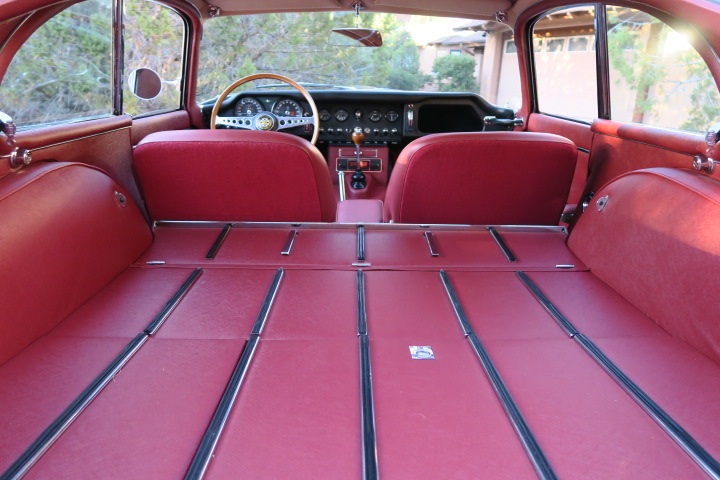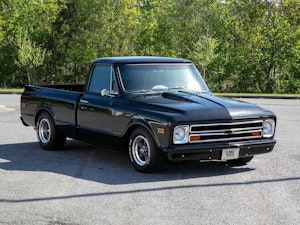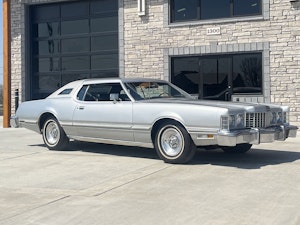Media | Articles
Patrick Bedard’s E-Type restoration ran out the clock and then some
Please welcome Patrick Bedard to our little corner of the automotive Web. He’ll need no introduction to anyone who remembers the glory years of Car and Driver. For the rest of you: Patrick worked for Chrysler before single-handedly redefining automotive journalism at C/D. He lived the impossible dream of going from SCCA club racer to Indy 500 qualifier—a dream that ended in fire and blood. When I came to Hagerty, bringing Mr. Bedard back to the readers was on the very top of my priority list. Please enjoy his latest work, which concerns his long-term restoration of a stunning Jag XKE, and the stories to come. — Jack Baruth
There’s a sculptural purity about the Jaguar E-Type that makes it irresistible to me—a Venus on wheels, the melding of motion with emotion. I bought my Series 1 two-seat coupe 40-some years ago thinking it was the only car on the planet I wanted to get old with. Now I am old, as is the E-Type, and we both got a lot older through a 22-year, down-to-bare restoration.
It wasn’t done on a whim. By the time it turned 30, my “nth-hand” 1966 XKE coupe would cringe whenever its garage door rolled up: Oh, no, you’re not going to drive me! Then it would be my turn to cringe—at its overheating habits, at the dings and ripples from too many lonely hours in public parking awaiting previous owners. Why not restore it? I was only working two jobs at the time, and my four-space garage was both heated and cooled. Delusions start with less. I fancied myself an archaeologist digging into the leavings of British engineers, circa 1960. I’d do the disassembly work, delight in the exotic machinery, and schlep the parts around to various specialists.
Removing the bonnet is a four-man job. One person, or maybe two, is better for extracting the engine; forget the six-pack, buy a Haynes Manual, put on something calming—Haydn concertos are good. Elevate the rear wheels 12 inches on platforms that allow the car to roll 18 inches fore and aft; don’t question this. Lift by the cylinder head’s front loop. A little hammering will release the torsion-bar reaction crossmember, drop the trans mount, and the whole powertrain comes out nose up like a marlin alongside a sportfisher.
Marketplace
Buy and sell classics with confidence

The engine went off to Woodland Hills, California, to a one-man shop doing business as Straight Six Jaguar. The work bay had lines of salvaged Jaguar sixes stacked along the walls like the bags down at the Feed & Seed, laced through with cables to keep the occasional tremor from tumbling them down on his head. He was 60-some and mildly over-torqued, but magazine writers gravitate toward eccentrics. Some years later, Peter Egan, the noted R&T columnist, wrote that during his E-Type restoration he had taken his cylinder head to the same bloke.
A breathtaking, black Jaguar XK150 won best of show at Sedona, Arizona, that year. The owner showed me photos of the rusted hulk it had been, with all credit to Rusty and Bob in a shop over the hill in Prescott. When Rusty looked at the E-Type’s tilt-up bonnet—it comprises most of the body forward of the windshield, 11 major stampings plus lights, bumpers, latches, and ducts for the radiator and heater, all held together with old-style slotted screws—he said, “This all has to come apart. You’ll have rust bubbling in all of the seams if you don’t strip, pickle, prime, and paint each part separately.” I could hear a distant cash register ringing.
The original paint under the flaking respray was Opalescent Silver Blue, a cautiously iridescent gray-blue. I’d liked the metallic effect in 1966, but by the late ’90s the pigments had become far more dramatic. From glittery flare, they’d flop to somber mystery as the body contours rolled toward shadow. Ten years from now, no one will remember what a new E-Type looked like, but I had no doubts. And they didn’t flop.
Unable to duplicate the original “opalescence,” we settled on a non-metallic dark blue seemingly faithful to the heavily fingerprinted color chip on an original Jaguar sample. Rusty and Bob turned out to be wet-sanding zealots. Now I know what makes those mirror-straight flanks on show cars: m-o-n-e-y. The job came to $10,000.
Very few pieces of a car actually wear out, so most of restoration comes down to making old stuff look new again. Numerous small bits—throttle linkage, bonnet latches, seat tracks—had a tarnished silvery finish that looked to me like cadmium plating. It was common in the ’60s, but the process is in bad environmental odor now. Furtively, I asked around and was given an address in Phoenix.

Through the chain-link fence I could see low tanks made of concrete blocks, all outside under a rickety shade structure. An old man bending over one of the tanks nodded toward a concrete building, a bunker really, with no windows. The door opened to black dark inside. “Whaddaya want?” boomed a basso voice. When my eyes adjusted, I could make out an immense black man. No small talk.
“Cad?”
“Yeah.”
“When?”
“Next week.”
His plating was Pebble Beach quality. Good thing; a blacked-out bunker is not the place I want to argue for a do-over.
From the car’s mechanical details I can see that Jaguar engineers were chasing perfection. One example: From the gas pedal on the left, motion is transferred to the three SUs on the right by a pull rod across the firewall. It is infinitely adjustable for length, thanks to a collet on one end. The elegance of that detail still delights me.
Another perfectionist solution: The fuel pickup pokes down into a sump extending several inches below the tank bottom, so no matter the cornering or braking forces, the pump can slurp up the last thimble full of gas in the tank.
Other details presented problems. Hot water for the heater on the left circulates from the right side of the engine through three steel pipes running behind the firewall. They are entirely hidden except for the stub ends poking forward of the wall, where hoses connect. No surprise, those stubs were pitted by corrosion. A leak within the bulkhead would be a disaster. Feeling lucky? Stainless replacements are available for under 100 bucks. With the engine, windshield, and dash top removed, I could drill the rivets holding the pipes in place and reach one hand through a Big Mac-size opening on the cockpit side of the bulkhead to pull them out. But to position the new pipes, two hands were needed through the hole, and mine were too big.

Hey, hun, got a minute? Turns out that my sweet Laurie Ann knows enough expletives to be a real mechanic. Success followed shortly after my lesson in adjectives.
When the engine was done, I grabbed my checkbook and headed west. Although he hadn’t mentioned it previously, the bloke was not about to turn loose of that engine until he had green dollars in hand. Uh-oh. This man did not expect me to be a satisfied customer.
When I fired it the first time, oil sprayed out like a Texas gusher. Mea culpa, the eccentric Jaguar guru was my choice. That’s where the restoration stalled. I had other commitments. We remodeled a house to live in, then built another from scratch and did an extensive enlargement on yet another. Years went by. It finally dawned on me that eternity is a long time to go unforgiven, which would be my fate if I checked out and left Laurie Ann a shop strewn with Jaguar parts.
XKs Unlimited, the Jaguar resto shop in San Luis Obispo, California, had an opening about six months out and could rebuild the engine and reassemble everything I hadn’t already finished. The archeological dig was fun, but my notes for reassembly were distressingly sketchy after two decades.
The pros bring different values to the job. I thought rejuvenating existing parts where possible—the gas tank, for example—was the essence of restoration. But when the parts shelves groan with every repro component as they do for an E-Type, the pros are quick to reach for new. My meticulously resuscitated gas tank went to scrap. New parts not only save the labor cost of rubbing the grunge off old components, they shorten the time to completion and probably make a better car in the end.
The Jaguar was returned to me with plenty of those new parts under its painted-and-plated skin. After 22 years, my no-longer-cringing E-Type looks new and drives new, and Laurie Ann says I’m back to long-run copacetic with her—unless I take something else apart.










